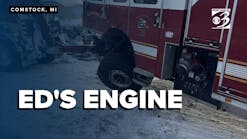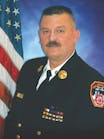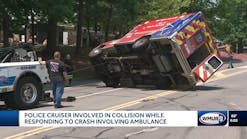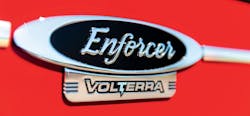Texas Department Places 'Blocker' Apparatus in Service
Firefighters and other responders working on some of the busiest stretches in Texas now have an added level of safety with apparatus that were recently placed in service.
The Irving Fire Department has placed two “blocker” apparatus in service and the department will be adding three more blocker units in the coming months.
The department covers 39 miles of major thoroughfares and responds to an average of 850 accident scenes that require blocking annually.
Fire Chief Victor Conley said, “It took two years to get that program going, but it’s been great.”
Irving currently operates from 12 fire stations housing 12 engine companies, five truck companies and 10 mobile intensive-care units protecting 237,000 residents in 67 square miles. The city is situated between northwest Dallas and Dallas-Fort Worth International Airport, making it home to some of the busiest highways in the state.
Community risk-reduction report
Conley was in the second year of the Executive Fire Officer program at the National Fire Academy, when he was assigned research on community risk reduction (CRR) and his research efforts took a spin on the traditional fire and life safety measures that most think about when it comes to CRR.
Conley didn’t have to look too far for a case study—in July 2015, Irving Ladder 52 was called to block traffic as police conducted an investigation on a busy interstate. An hour after it was parked in a blocking position, an 18 wheeler hit the apparatus at close to 70 mph.
“Instead of pushing it, that 30-ton truck ladder spun 180 degrees and rolled over,” Conley said. “Two firefighters ended up on the service road and the officer was pushed down the freeway.
The 18 wheeler caught fire on impact and the driver died.
“We were lucky not to lose our firefighters.”
Over a five-year period, nine Irving fire apparatus were struck while blocking. The damage caused the department to scrap two of those vehicles, including Ladder 52.
“Our frontline equipment was getting hit like crazy,” Conley said. “You’ve got people on cell phones, rubbernecking—it’s dangerous.”
The department was already using best practices for blocking and safety on busy thoroughfares.
Conley’s research showed those nine accidents caused more than a year-long period where the apparatus were out of commission, forcing the department to operate with well-used reserve apparatus. He added that the apparatus sustained over $1.5 million in damages, plus tens of thousands of dollars for medical expenses for the injured firefighters.
When Irving was preparing to auction off their older reserve pumpers, Conley said they could find a new purpose for those vehicles and save the city money since they were auctioning them off for pennies on the dollar.
“I figured we’re not getting anything for these…they’re already equipped with lights and graphics, so why not repurpose them.”
Since the apparatus are considered frontline apparatus, should one get damaged in a crash, the city can collect insurance money to help purchase a new rig.
Apparatus placed in service
The blocker units will be assigned to the five ladder companies around the city. Currently, Irving has two blocker units in service—Blocker 12 was placed in service in October 2017—and the remaining rigs will be placed in service once new pumpers are placed in service.
If the ladder company is assigned to a freeway incident, a ladder company firefighter will drive the blocker to the scene, position the rig and then join the ladder crew working in the hot zone at an incident scene.
When traffic management is needed—such as assisting police--both the blocker unit and ladder company will respond. After the firefighter sets the blocker up, they’ll get back on the aerial apparatus and the full crew will return to service.
When the incident is mitigated, they’ll return to pick up the blocker unit.
“We’re still working to get the bugs out of the process,” Conley said.
The two pumpers were stripped bare, except for the warning equipment. Traffic management equipment, including cones and flares, are still carried on the rigs, plus absorbent for spills.
“We don’t worry about the pumps and the auxiliary appliances,” Conley said, noting that the sole mission is protecting the people on the roadway. “They’ll keep water in the on-board tanks, if there are no leaks, to add weight to the blocking rig.”
The department installed three directional arrow boards on the apparatus. One is located on the back and one on each side toward the rear of the apparatus, to give maximum coverage during various blocking scenarios.
Traffic management best practices
The department already employs tactics to reduce the amount of time responders are on the roadways, including the use of the International Association of Fire Chief’s (IAFC) best practices for roadway safety.
Firefighters have an operating guideline for working safely near traffic and the use of the blocker rigs will be added to it.
“We’ve been using that guideline for years, but this is something we can do to improve our safety.”
Another measure is making sure wreckers arrive within 20 minutes of being requested to expedite the removal of damaged vehicles, whether it’s towing them away, or moving them off the main roads to a staging area.






